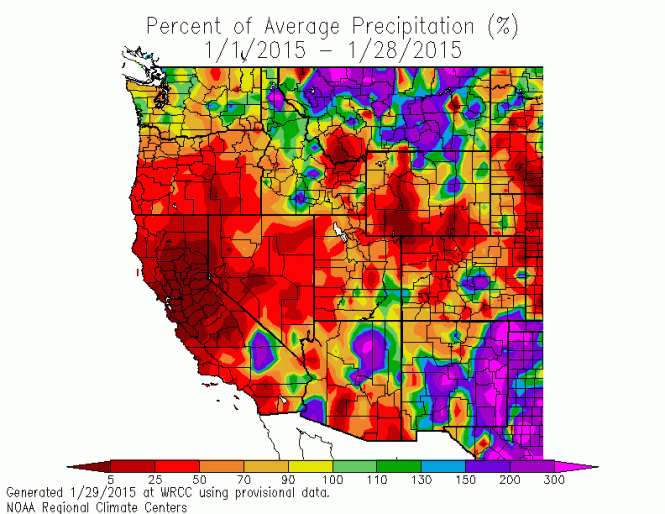The regional precipitation for the western states of the U.S. during the recent 5 years has been falling below normal. The blue line is the historical average. Winter months are normally the wettest. Instead, the red bars indicate below normal amounts each year. One year ago, I wrote about this situation. The much needed precipitation is not coming.

Despite a brief period of rain and snow in Nov/Dec, the region has returned to below normal precipitation in what should be a rainy season. Data from the Western Regional Climate Center for January 2015 shows much of the region receiving much less than the average (red and orange).

What About El Niño?
Earlier in 2014, hopes were building for the formation of an El Niño. In May, I posted some information about El Niño formation and why it might help the western states. The odds of El Niño have slowly decreased during the year. They are now at 50-60% which is not strong. There were promising signs early in the winter. The chart above shows that has changed. The region has also been about 5˚F warmer than average for the month of January.
By November 2014, climate scientists were hoping to see signs of the El Niño having an effect on the Jet Stream and weather patterns that would be helpful.
Outlook
Dr. Jeff Masters, co-founder of Weather Underground, wrote in his excellent blog last week that California is slipping back into exceptional drought since the brief rains. (Another post by Jeff January 30 reiterates) The chart shows that 58% of the state was in exceptional drought during the summer dry period. That fell to 32% in December. It has climbed back up to 39% as of mid-January. The western states will be moving into the dry months soon. Unless precipitation comes, the western states’ reservoirs and snow packs will remain depleted.

What I see is a lot of red and I learned in elementary school that a lot of red on paper is no good…
It’s true. I was a teacher and used up a lot of red pens.
Parts of Texas just beyond your map are in an exceptional or extreme drought as well:
http://droughtmonitor.unl.edu/Home/StateDroughtMonitor.aspx?TX
The lakes that provide water to Austin have been under 40% full for the past year.
Indeed they are. Even up here in IA, we are drier than normal. Nothing compared to those areas in TX and the west.
Reblogged this on A fork in the road and commented:
This is not good news for those of us planning a thru hike of the Pacific Crest Trail which passes through the heart of the afflicted territory. Of course, hiking is only recreational. Much more importantly, we need to be aware of the drought’s effect on this vast agricultural region.
Although I’m not there, it’s been tough in California!
The U.S. government has long supported a bi-partisan attitude relative to subsidizing agriculture and for the most part it has greatly benefitted the country, stabilizing prices, ensuring a reliable supply of food, and incidentally creating a great many farmer millionaires. But because of the looming water scarcity crisis I see a serious debate coming over the price and availability of water. It is bound to be politically contentious and may make the XL pipeline look like a mere pimple in comparison.
I checked and right now, if I divide my water bill by the gallons used, I get under 3 cents a gallon. With this drought, that’s likely to change radically and the era of running water wastefully down the drain is going to end, shocking the culture and causing politicians to run for the exits.
I agree. You and many others see a growing problem over water availability. We will add that to the mix with oil, religion, politics, gender, etc, … there will be plenty to fight over in the future.
I understand that until recently Chicago residents didn’t even have water meters!!! They do now, though and there was quite a stir about it.
@ MELISSA,
That’s interesting, about the Chicago water meters. Just a speculation, but when things impact people personally it just might spur better voter turnout. Sounds like a positive to me.
Yes, it sure was a wake-up call. Sounds like the good folks in CA could use the same one.
I wonder how they would test precipitation in the natural occurring rainforests of the world. Would more drought on a worldwide scale affect the naturally occurring rainfall of these rainforests? I suppose it would, as this is precisely the effect of the gradual deforestation of the earth, as the rainforests actually behave as they were “lungs” in the atmosphere. Does that make sense?
I think so. Drought on a worldwide scale would have impacts in many places. At this time, we are seeing droughts in specific regions while precipitation is increased in others. There is still basically a balance. But their are more extremes in the plus and minus sides.
I am encouraged by learning that San Diego is developing a desalinization plant. If that works well I would think that any nation with a shoreline could do so. This will have the added benefit of taking some of the extra water out of the oceans.
Desalination is expensive. Many poor countries can’t afford it. But, costs are coming down. It will be an increasingly attractive option.